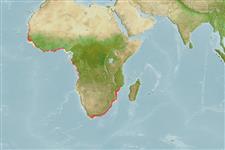>
Mugiliformes (Mullets) >
Mugilidae (Mullets)
Etymology: Chelon: Greek, chelone = turtle (Ref. 45335).
Eponymy: Auguste Henri André Duméril (1812–1870), was a physician and zoologist like his father (see next entry) and followed much in his father’s footsteps. [...] (Ref. 128868), visit book page.
More on author: Steindachner.
Issue
Genetic data indicate that Chelon dumerilii is a complex of two species, one from Northwest and West central African coasts (= C. dumerilii), one in southeastern African coasts (Refs. 114224, 123262).
Environment: milieu / climate zone / depth range / distribution range
ນິເວດວິທະຍາ
ສັດທະເລ; ນ້ຳຈືດ; ນ້ຳກ່ອຍ ອາໄສຢູ່ໃກ້ໜ້າດິນໃຕ້ພື້ນທ້ອງນ້ຳ; ກຸ່ມປາຫຼຊະນິດປາທີ່ມີການເຄື່ອນຍ້າຍຈາກແມ່ນ້ຳລົງສູ່ທະເລເພື່ອວ່າງໄຂ່ (Ref. 51243). Tropical; 20°C - 25°C (Ref. 13614); 21°N - 36°S, 20°W - 38°E
Eastern Atlantic: Mauritania to South Africa (Ref. 3573, 57400). Western Indian Ocean: Delagoa Bay, Mozambique to Mossel Bay, South Africa (Ref. 81659).
Length at first maturity / ຂະໜາດ / ນ້ຳໜັກ / Age
Maturity: Lm 17.0 range ? - ? cm
Max length : 40.0 cm TL ຕົວຜູ້/ບໍ່ມີເພດ; (Ref. 4393); common length : 18.0 cm SL ຕົວຜູ້/ບໍ່ມີເພດ; (Ref. 7399)
ຄີ (ໜາມ)ແຂງຢູ່ຫຼັງປາ (ທັງໝົດ) : 5; ຄີຫຼັງຂອງປາ (ຄີອ່ອນ) (ທັງໝົດ) : 8 - 9; ຄີ(ໜາມ) ແຂງຢູ່ຄີກົ້ນປາ
ກຸ່ມປາກະດູກແຂງ
ຄວາມຖີ່ຂອງກຸ່ມຖ່າຍທອດພັນ
ປາທີ່ມີການເຄື່ອນຍ້າຍຈາກທະເລໄປຫານ້ຳຈືດ ແລະນ້ຳຈືດຫາທະເລ
ປາທີ່ມີການເຄື່ອນຍ້າຍຈາກທະເລແລະໄປໄຂ່ຢູ່ນ້ຳຈືດ
ຄີກົ້ນຂອງປາ
ສັດທີ່ມີກະດູກສັນຫັຼງ
ການຖ່າຍທອດທາງກຳມະພັນຈາກພໍ່ແມ່ຫາລູກ: 3; ຄີກົ້ນຂອງປາ: 8 - 9. Diagnosis: 8-9 anal soft rays; anal fin and lower lobe of caudal fin whitish or greyish (Ref. 57400). Body with ctenoid scales except for anterior predorsal scales which are cycloid and extend to anterior nostril or slightly beyond (Ref. 81659). Scales numerous (Ref. 57400), not large, 33-41 in a longitudinal series (excluding scales on caudal fin base), 11-14 scale rows between pelvic and first dorsal fin (Ref. 81659). 5-8 mucous canals on scales in front of 1st dorsal fin (only 1, less often 2 or 3, in other Liza species (Ref. 57400). Posterior end of maxilla sigmoid, curved down over premaxilla; serrate, anteroventral edge of lachrymal distinctly concave; pharyngobranchial organ with 1-2 valves, anteroventral valve a moderate size, semi-lunate flap, posterior valve usually vestigial, as a small nodule or, at most, a low papillate fold, and may be absent (Ref. 81659).
Inhabit shallow coastal waters (Ref. 27121), including estuaries (Ref. 2683, 57400, 81659), lagoons (Ref. 57400), tidal rivers (Ref. 3573), freshwater and supersaline environments (Ref. 81659). Feed on plankton and detritus (Ref. 28587). Oviparous, eggs are pelagic and non-adhesive (Ref. 205). Shows a remarkable adaptation to hyperhaline environments (up to 97‰ in the Sine Saloum in Senegal)(Ref. 57400). Specimens from tropical East Atlantic reaching maximum of 280 mm SL and common to 180 mm SL (Ref. 81659).
Life cycle and mating behavior
ການຈະເລີນເຕັມໄວ | ການສືບພັນ | ການວາງໄຂ່ | ໄຂ່ | ຄວາມດົກຂອງໄຂ່ປາ | ຕົວອ່ອນ
Thomson, J.M., 1990. Mugilidae. p. 855-859. In J.C. Quero, J.C. Hureau, C. Karrer, A. Post and L. Saldanha (eds.) Check-list of the fishes of the eastern tropical Atlantic (CLOFETA). JNICT, Lisbon; SEI, Paris; and UNESCO, Paris. Vol. 2. (Ref. 7399)
IUCN Red List Status (Ref. 130435: Version 2024-2)
Threat to humans
Harmless
Human uses
ການປະມົງ: ເປັນສີນຄ້າ
ເຄື່ອງມື
Special reports
Download XML
ແຫຼ່ງອີນເຕີເນັດ
Estimates based on models
Preferred temperature (Ref.
123201): 19.6 - 27.9, mean 26.1 °C (based on 96 cells).
Phylogenetic diversity index (Ref.
82804): PD
50 = 0.5005 [Uniqueness, from 0.5 = low to 2.0 = high].
Bayesian length-weight: a=0.01288 (0.00835 - 0.01988), b=2.99 (2.87 - 3.11), in cm total length, based on LWR estimates for this species & Genus-body shape (Ref.
93245).
ຊັ້ນເຂດຮ້ອນ (Ref.
69278): 2.7 ±0.32 se; based on food items.
Generation time: 2.6 ( na - na) years. Estimated as median ln(3)/K based on 2
growth studies.
ຄວາມຢືດຢຸ່ນ (Ref.
120179): ສູງ, ປະຊາກອນຕຳ່ສຸດທີ່ໃຊ້ເວລາສອງໜ້ອຍກວ່າ 15 ເດືອນ (Preliminary K or Fecundity.).
Fishing Vulnerability (Ref.
59153): Low to moderate vulnerability (26 of 100).
Nutrients (Ref.
124155): Calcium = 98.3 [27.6, 541.6] mg/100g; Iron = 0.84 [0.43, 1.47] mg/100g; Protein = 17.8 [16.4, 19.3] %; Omega3 = 0.487 [0.210, 1.143] g/100g; Selenium = 17 [7, 41] μg/100g; VitaminA = 14 [4, 41] μg/100g; Zinc = 0.934 [0.591, 1.443] mg/100g (wet weight);
